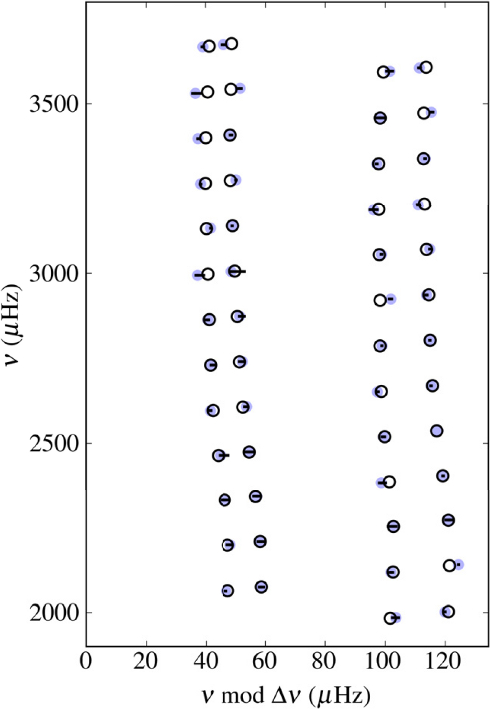 CAUP Researchers: Michaël Bazot, Tiago J. L. C. E. Campante, Xavier Dumusque, Mário J. P. F. G. Monteiro, Nuno C. Santos, Sérgio A. G. Sousa Estimating the p-mode frequencies of the solar twin 18 Scorpii, Solar twins have been a focus of attention for more than a decade, because their structure is extremely close to that of the Sun. Today, thanks to high-precision spectrometers, it is possible to use asteroseismology to probe their interiors. Our goal is to use time series obtained from the HARPS spectrometer to extract the oscillation frequencies of 18 Sco, the brightest solar twin. We used the tools of spectral analysis to estimate these quantities. We estimate 52 frequencies using a Markov chain Monte Carlo algorithm. After examination of their probability densities and comparison with results from direct Maximum A Posteriori optimization, we obtain a minimal set of 21 reliable modes. The identification of each pulsation mode is straightforwardly accomplished by comparing to the well-established solar pulsation modes. We also derived some basic seismic indicators using these values. These results offer a good basis to start a detailed seismic analysis of 18 Sco using stellar models.
The search for solar twins is currently a very active field of study within astronomy. This effort stems from both the attempt to find the solar twin which is most similar to the sun and also from trying to understand whether or not the Sun is a peculiar star. Recently, this quest has been aided by the addition of new observational data, including spectropolarimetric, interferometric and asteroseismic measurements. Specifically, the asteroseismology quantities present a unique opportunity to study the stellar interior, as they are directly dependent on these conditions and, thus, are not considerably affected by the poorly-modeled outer layers of the star. In this study, the team used observational data of the brightest known solar twin, 18 Scorpii, obtained with the HARPS spectrograph at La Silla Observatory for previous work [1]. The data comprises a total of 2833 radial velocity determinations taken during 12 nights from 10 to 21 May 2009. After correcting the power spectrum obtained (Fig. 1) for several sources of noise – namely activity of the star, granulation and instrumental noise - the modeling of the spectrum was performed using a Markov Chain Monte Carlo estimation, through the Metropolis-Hastings algorithm. The results obtained were then compared with those obtained from scaling solar models to the physical properties of 18 Sco (Fig. 2). In order to further evaluate the robustness of the results obtained, they were also compared with those obtained using a different statistical method – the maximum a posteriori approach – as well as with two different algorithms for time-domain modeling. Overall, the results obtained from every method were found to be in good agreement and allowed the confirmation of 21 reliable pulsation modes while another 19 modes were found to be worth considering. Eleven additional modes were rejected after comparing the results obtained with the different methods.
The average large and small separations, widely used in asteroseismology, were also determined with this work. The average large separation was found to be <Δν0,2> = 133.8 ± 0.2 µHz, which implies a mass of 1.01 ± 0.03 solar masses for 18 Scorpii. This work, thus, constitutes a major foundation to further asteroseismological studies of 18 Sco. This project was led by the CAUP member Michaël Bazot, who also obtained the observational data, performed the Bayesian formulation of the problem, the time-domain modeling of the data and compared the results obtained with the different methods used. The remaining CAUP members performed the fit of the background components of the power spectrum and participated in the proposal and results discussion. [1] Bazot et al., “The radius and mass of the close solar twin 18 Scorpii derived from asteroseismology and interferometry”, Astronomy and Astrophysics, Volume 526, L4, February 2011 |























